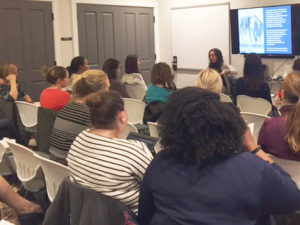From Diversity & Inclusion to Belonging: Discovering Bias with Malia Lazu

JL Boston members listen to Malia Lazu during a recent training.
by Emily Thomsen
Back in November, a group of League members, including myself, joined Malia Lazu at headquarters for an open and honest discussion about diversity, inclusion, and the true meaning of bias and how it impacts our everyday lives, particularly in the League.
While racism and bias are never easy to talk about, the Junior League of Boston has taken on the tough issues of diversity and inclusion, tackling them through the Diversity and Inclusion Task Force and a series of member trainings and discussions.
Malia is the founder of Urban Labs as well as President of the Epicenter Community, and is no stranger to facing diversity issues and discussing racism in the Boston community.
Through her engaging and open discussion style, we explored who we are as a League and how we want to evolve going forward. Malia helped talk us through what diversity looks like in the context of an organization like ours and what it truly means to diversify.
Some takeaways and points to consider were these key terms and concepts:
- Implicit Bias: Attitudes or stereotypes that affect our understanding, actions, and decisions in an unconscious manner.
- Diversity: “Diversity” has come to refer to the various backgrounds and races that comprise a community, nation, or other grouping. In many cases, the term does not just acknowledge the existence of variety in background, race, gender, religion, sexual orientation, and so on, but also implies an appreciation of these differences.
- Structural Racism: A system in which public policies, institutional practices, cultural representations, and other norms work in various, often reinforcing ways to perpetuate racial group inequity. It identifies dimensions of our history and culture that have allowed privileges associated with “whiteness” and disadvantages associated with “color” to endure and adapt over time. Structural racism is not something that a few people or institutions choose to practice. Instead it has been a feature of the social, economic and political systems in which we all exist.
The structural racism perspective can be distinguished from a diversity perspective in that structural racism takes direct account of the striking disparities in well-being and opportunity areas that come along with being a member of a group, and works to identify ways in which these disparities can be eliminated.
I personally gained a lot from this training and while these conversations are never easy, it is the tough conversations that usually benefit everybody the most. While we certainly have a lot more work to do, this was a great start! I highly suggest joining the discussion by attending the second and third trainings on Monday, February 12th and Tuesday, April 24th.
